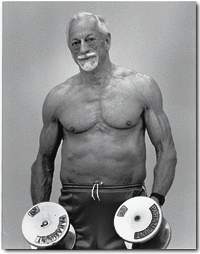Main Menu · Search ·Current Issue ·Contact ·Archives ·Centennial ·Letters to the Editor ·FAQs

| The Floodlit Night Sky | The Stalker's World | |
| Violent Chimps | A Sports Doc for the Geriatric Jock | |
| E-mail and Web Information | ||
 California psychiatrist and weightlifter John Turner is 79, but his phsyique concedes little to age.From the book Growing Old is not for Sissies II, Pomegranite Press |
Picture an athlete. Chances are, what comes to mind is one of the glistening young bodies that ran, jumped, or swam its way through the Olympics last summer. Youth and sports are an old equation. But step outdoors and you'll notice that more people are remaining active or rediscovering sports well into their senior years.
This greater participation in sports naturally leads to more athletic injuries--and due to bodily changes, older athletes are at greater risk. But the medical community, which is well versed in sports medicine for the young, doesn't adequately consider the sports-medicine needs of the old, according to instructor in neurology David Burke, a physical medicine and rehabilitation physician at the Spaulding Rehabilitation Hospital in Boston. "Often, the primary-care physician advises an injured older athlete not to do the sport anymore, rather than saying, '[The injury] is to be accepted, and here's how it can be treated,'" he says.
Burke and his colleagues at Spaulding's muscular-skeletal clinic have launched perhaps the first practice that targets sports medicine for athletes 60 years of age and older. They may also be the first to identify this field as "geriatric sports medicine." "As the Baby Boomers mature," Burke says, "aging athletes will be coming in with more and more frequency. We have to be prepared to deal with them."
What's at stake is the athlete's quality of life, Burke explains. People who maintain their strength are less susceptible to falling, a major cause of injuries and even death in the elderly. Women, who are vulnerable to osteoporosis after menopause, can prevent bone loss by engaging in weight-bearing sports. And exercise is an effective treatment for depression, for which elderly people are at increased risk. "When people do things that are good for them cardiovascularly, it's good for them mentally," he says. "Not being able to do that any more really changes their whole outlook on life."
Burke notes that much of the decline in strength and flexibility normally attributed to aging actually stems from disuse. "People thought that when they got beyond 18, the slide downhill was inevitable," he says. "But the loss of strength is more from lack of using the muscles than the aging process." Aerobics, weightlifting, running, golf (minus the golf cart), and martial arts can dramatically slow the loss of strength.
Burke advises older athletes to adhere to different rules than their younger counterparts do. Senior athletes, for instance, have less tissue elasticity. Thus an 18-year-old can run without stretching, but an octogenarian marathoner must stretch well, both before and after running, or face an increased chance of muscular-skeletal damage. And older athletes' metabolisms are also less flexible: they respond less well to temperature changes. Youthful runners can log mileage on a cold day and remain oblivious to heat loss, but older joggers should wear layered clothing, gloves, and a hat. In hot weather, older athletes must pay attention to the time of day. A 30-year-old executive can recover quickly from a lunchtime run on a hot and humid day, but her 65-year-old boss should wait until early evening, and take special care to drink water before and after running.
Of course, injuries still happen. But older athletes can usually remain active by modifying their routine, Burke says. Runners with an arthritic knee may halt the injury's progress and reduce pain by changing to a more shock-absorbing shoe, running on a softer surface (a track instead of a street), changing stride to minimize bouncing, and avoiding downhill slopes. Older participants in Burke's favorite sport, tae kwon do, can forestall injuries by beginning with a formal stretching program, not breaking wood with their hands, and kicking no higher than an opponent's lowest ribs.
Burke, a second-degree black belt himself, saw a tae kwon do classmate use these methods while progressing from white belt (the beginning level) at age 67 to black belt (the expert level) at age 71. The lesson learned: age and injury don't necessarily mean an athlete should back off. "You can't always change the sport enough to continue," Burke says. "But more often than not, you can."
~Lynda Radosevich